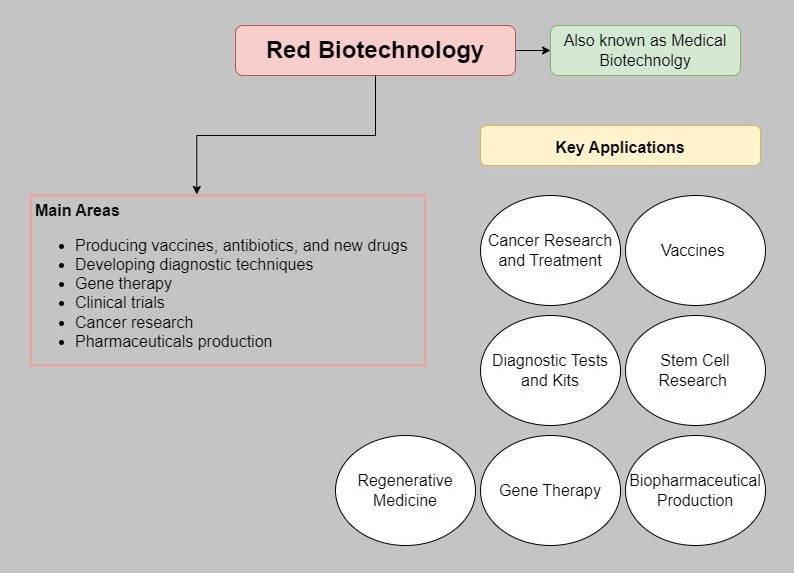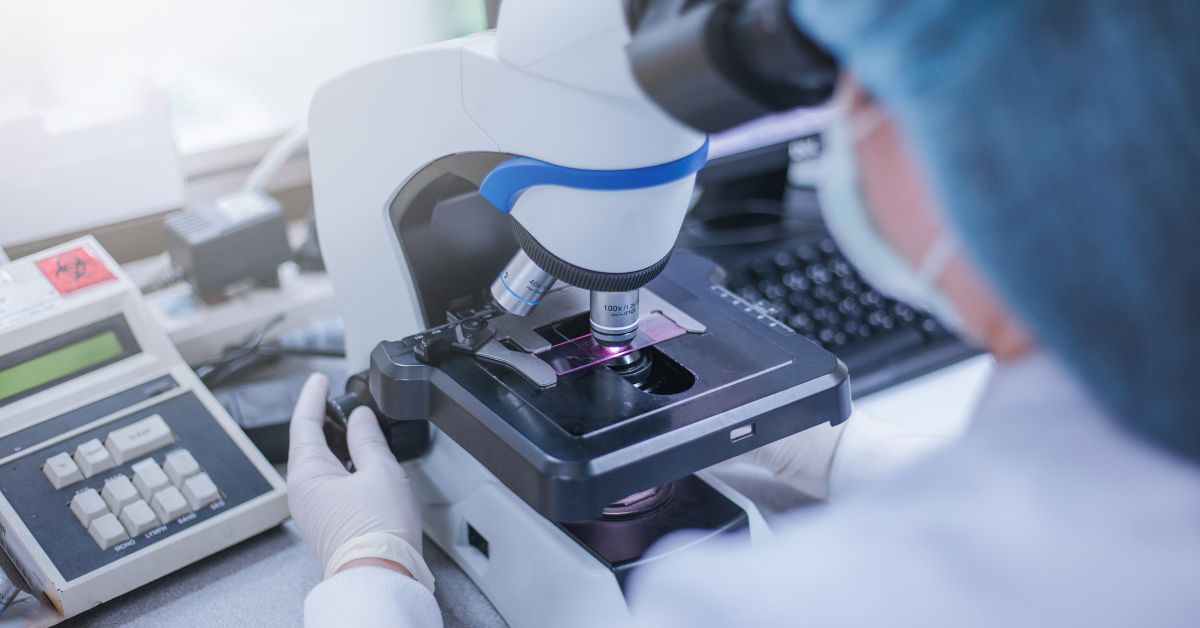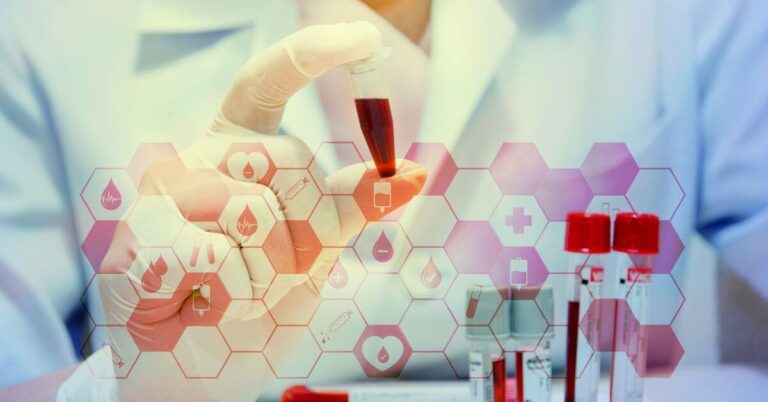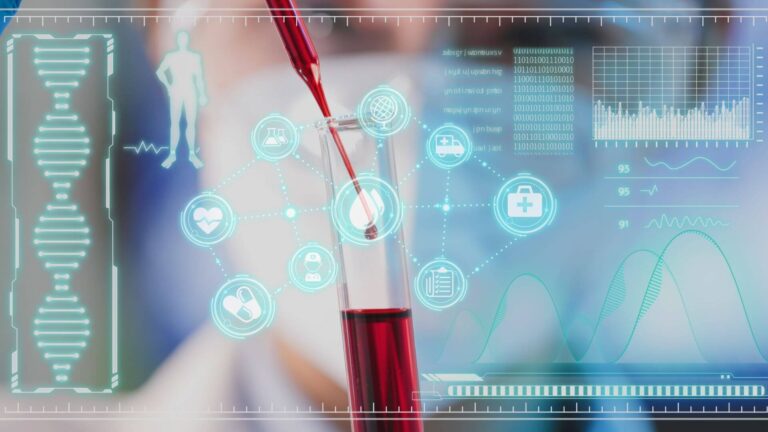Red Biotechnology: Definition, Types, And Applications
What Is Red Biotechnology?
Red biotechnology is the use of biotechnology in the medical and pharmaceutical industries, focusing on improving human health. It involves the production of vaccines, antibiotics, new drugs, regenerative therapies, artificial organs, diagnostics tests, stem cells, antibodies, etc. to treat diseases.
What Is Red Biotechnology Also Known As?
Red biotechnology is also known as:
- Medical biotechnology
- Biopharmaceutical biotechnology
- Health biotechnology
Who Is The Father Of Red Biotechnology?
- The term “biotechnology“ was first coined in 1919 by Hungarian engineer Karl Ereky, who defined it as “all lines of work by which products are produced from raw materials with the aid of living organisms.”
- Genentech founders Robert Swanson and Herbert Boyer helped commercialize biotechnology.
- Arthur Kornberg first synthesized DNA in a test tube in 1967.
- Werner Arber, Daniel Nathans, and Hamilton Smith helped discover restriction enzymes that allowed gene splicing.
- John Crowley who founded biotech companies focused on developing treatments for rare diseases.
What Is The Origin Of Red Biotechnology?
While the root word “biotechnology” dates back to 1919 from Karl Ereky, the more specific “red biotechnology” term originated in 2003 from Dr. Rita R. Colwell’s framework of color-coding the subdisciplines of biotechnology.
History Of Red Biotechnology
Key historical milestones of red biotechnology:
- 1919: Established the term “biotechnology” by Karl Ereky.
- 1950s-1960s: The development of insulin and interferon using microorganisms.
- 1977: First recombinant DNA insulin is produced in E. coli bacteria.
- 1982: FDA approved the first recombinant DNA-derived biopharmaceutical, human insulin made by Eli Lilly.
- 1984: The first monoclonal antibody to prevent kidney transplant rejection. approved by FDA
- 1986: Recombinant vaccine for hepatitis B.
- 1990: First FDA-approved gene therapy treatment performed on a 4-year-old girl with ADA deficiency.
- 1997: Dolly the sheep cloned using adult cell nuclear transfer, demonstrating the potential for regenerative medicine.
- 2003: Completion of the Human Genome Project expanded understanding of genetic diseases.
- 2012: Development of first cancer immunotherapy drug (Yervoy).
- 2017: FDA approved first CAR T-cell therapy for certain sand lymphomas.

What Is The Main Focus Of Red Biotechnology?
The main focus of red biotechnology is on medical and pharmaceutical applications.
Such as:
- Producing vaccines, antibiotics, and new drugs
- Developing diagnostic techniques
- Gene therapy and regenerative medicine using stem cells to regenerate damaged tissue
- Molecular diagnostics
- Clinical trials
- Disease research
Categories Of Red Biotechnology
Major categories of red biotechnology include:
1. Pharmaceuticals and drug development: This involves using biotechnology to discover, develop, and manufacture new medicines, vaccines, antibiotics, and therapeutic drugs to treat diseases.
2. Gene and cell therapy: This includes gene editing technologies like CRISPR to correct genetic defects and stem cell therapies to regenerate damaged tissue and organs.
3. Tissue engineering and regenerative medicine: Growing tissues and organs in the lab for transplantation through the use of stem cells, biomaterials, and growth factors.
4. Diagnostics: Developing rapid, accurate, and cost-effective tests and devices for early disease diagnosis, personalized medicine, pharmacogenomics, and point-of-care testing.
5. Medical biotechnology and devices: Engineering biological systems to develop implants, prosthetics, biocompatible materials, and devices to improve therapeutic outcomes.
6. Bioinformatics and computational biology: Using advanced computer science and statistical techniques to store, analyze, model, and interpret large biological and medical datasets to enable precision medicine, drug discovery, etc.
There are other 3 types of biotechnology:
- Green biotechnology
- Blue biotechnology
- White biotechnology
Red Biotechnology Examples
Key examples of red biotechnology:
Gene therapy
Using genetic engineering to treat diseases by replacing defective genes with healthy ones. This includes developing viral vectors to deliver the new genes.
Stem cell therapy
Using stem cells to regenerate damaged tissues and organs. This involves both research into using embryonic stem cells and adult stem cells from bone marrow and umbilical cord blood.
Pharmacogenomics
This involves studying how genes affect a person’s response to drugs so that drugs can be tailored to a person’s genetic makeup. It enables personalized medicine approaches.
Monoclonal antibody drugs
Producing humanized antibodies that can target specific cells, like cancer cells. Examples include drugs for cancer, autoimmune diseases, and preventing organ transplant rejection.
Recombinant protein drugs
Scientists and doctors use genetically engineered cells that can produce complex human proteins to treat diseases. Examples include insulin, growth hormone, and blood clotting factors.
Vaccine development:
Producing vaccines against infectious diseases using genetic engineering and cell culture methods. This includes traditional and mRNA vaccines.
Molecular diagnostics
Developing genetic and molecular tests to rapidly diagnose diseases, guide treatments, and screen for risk factors. Examples include PCR, microarrays, and sequencing tumor DNA.
Tissue engineering
Using cells, engineered biomaterials, and molecules to regenerate damaged tissues and organs. This can produce skin, cartilage, blood vessels, or even whole organs.
Red Biotechnology Products
| Categories | Treatments |
| Gene therapy | Cancers, hemophilia, muscular dystrophy |
| Stem cells | Spinal cord injuries, heart disease, diabetes |
| Antibody drugs | COVID-19, flu, HPV, hepatitis, etc |
Why Is Red Biotechnology Important?
Drug Development
Red biotechnology is used to develop new medicines, vaccines, diagnostics, and gene therapies that can treat diseases and improve human health. For example, immunology is a rapidly growing field within red biotechnology focused on developing new vaccines, antibodies, and cancer immune therapies.
Biopharmaceuticals Discovery
Red biotechnology enables innovations in personalized medicine, pharmacogenomics, biopharmaceutical production, and more that are revolutionizing healthcare.
Gene Therapy
There is a massive investment and a strong pipeline of new gene therapies, cell therapies, vaccines, and biologics in clinical development thanks to red biotechnology. In 2021 alone, over 4,000 patent applications were filed in the vaccines and antibodies space.
Medical Emergency
Red biotechnology provides solutions for major diseases like cancer that are growing in prevalence globally. It also facilitated the rapid development of COVID-19 vaccines during the pandemic.
Personalized Medicine
By leveraging genetics, red biotechnology enables more personalized therapies tailored to an individual patient’s disease and genetics, and it is leading to better patient outcomes.
Where Is Red Biotechnology Used?
The areas where red biotechnology is used:
1. Medicine and Healthcare
- Cancer research and treatment
- Diagnostic kits and molecular diagnostics
- Vaccine development
- Stem cell research and regenerative medicine
- Gene therapy
- Pharmacogenomics using genetics to guide drug development and treatment
- Blood products and diagnostics reagents
- Personalized/precision medicine
- Tissue engineering
- Biochips manufacturing
2. Veterinary Science
- Veterinary medicines and vaccines
- Poultry farming
3. Biopharmaceutical Production
- Biopharmaceutical production
- Antibodies production
Applications Of Red Biotechnology
Key applications of red biotechnology:
Cancer Research and Treatment
Patents related to cancer research account for a significant portion of red biotechnology patents. This includes research on new cancer therapies, diagnostic tests, and personalized medicine approaches.
Vaccines
Red biotechnology is being used to develop new and improved vaccines. The patents found related to vaccines aim to make them more effective and easier to administer. This has applications for human vaccines as well as veterinary vaccines.
Diagnostic Tests and Kits
Many red biotechnology patents are for new diagnostic tests and kits. These allow for earlier and more accurate detection of diseases and medical conditions. Some examples include kits for detecting cancer biomarkers or infections.
Stem Cell Research
Stem cells have many promising therapeutic applications and red biotechnology patents related to stem cells cover areas like tissue engineering and regenerative medicine research. Stem cells could be used to treat injuries, diseases, and age-related degeneration.
Gene Therapy
Gene therapy involves treating genetic diseases by adding functional genes or editing malfunctioning ones.
Fighting cancer by making tumor cells more vulnerable or stimulating the immune system against them, preventing heart disease by boosting blood vessel growth, restoring lost vision through genes that regenerate retinal cells, alleviating chronic pain by modifying neurological signaling, and enhancing vaccines by inserting genes that provoke robust and durable immunity.
Biopharmaceutical Production
Red biotechnology techniques are being used to improve and streamline the production of biopharmaceuticals like protein therapies and monoclonal antibodies. This helps make these important medicines more available and affordable.
Regenerative Medicine
Repairing or replacing damaged tissues and organs using approaches like biomaterials, tissue engineering, and cell therapy.
Red Biotechnology Advantages And Disadvantages
Advantages
- Promotes medical progress and development of new treatments and medicines for diseases
- Enables personalized medicine tailored to individual need
- Can help treat genetic diseases through gene therapy
- Used to develop vaccines and antibodies to prevent infectious diseases
- Can help regenerate damaged tissues and create prosthetics through tissue engineering
- Increases efficiency and sustainability of food production through innovations like meat alternatives
Disadvantages
- Poses ethical concerns around genetic engineering and cloning
- Potential health risks from unintended effects of genetic modifications
- Environmental risks if genetically modified organisms disrupt ecosystems
- This could lead to dependence on a limited range of genetically uniform products
- Expensive advanced treatments may exacerbate healthcare access inequalities
- Misuse of biotechnology knowledge could enable biological weapons development
Risks Of Red Biotechnology
- Risks to human life from clinical trials: As red biotechnology involves developing new medical treatments, there are risks to human life during clinical trials as the technologies are still new and not fully tested. There have been cases of injury and even death during trials. Extensive research and informed consent are critical before trials.
- Funding and priority setting: There are ethical concerns around how funding and resources are allocated between developing treatments for known diseases versus biodefense projects against potential future bioterrorism threats.
- Regulatory hurdles: Bringing new red biotechnology products to market faces complex regulatory processes that can cause delays and difficulties. The high rate of failure also poses financial risks.
- Societal acceptance: If sections of society view biotechnology negatively, it can influence political support and oversight, leading to more restrictive regulations focused on precaution over innovation. This is more of an issue for green biotechnology.
- Biosecurity concerns: While red biotechnology aims to develop treatments, there are risks that new genetic knowledge/techniques could enable biological weapons if containment fails or materials fall into the wrong hands.
Futures Of Red Biotechnology
- The red biotechnology market is expected to see strong growth in the coming years, with some projections estimating it will reach over $600 billion globally by 2032. Key growth drivers include advancements in genetic research, personalized medicine, and rising demand for innovative healthcare solutions.
- Emerging therapies in areas like regenerative medicine, stem cell therapy, and treatments for neurodegenerative disorders show great promise. Red biotechnology is expected to play a leading role in addressing major global health challenges like infectious diseases and emerging epidemics.
- Cancer research and treatment is a major area of focus and growth within red biotechnology. This includes the development of new drugs, diagnostic tests, and other innovations to detect and treat cancer.
- Gene therapy is also expected to see very high growth rates due to extensive research and drug development activities focused on using gene manipulation to treat diseases.
- Biopharmaceutical production is another key application segment that is driving growth. Red biotechnology techniques are being used to manufacture biologics, biosimilars, vaccines, monoclonal antibodies, and other therapeutic proteins.
- Key players leading innovation in the red biotechnology sphere include major pharmaceutical companies like Pfizer, Roche, and Novartis, along with specialized biotechnology firms focused on novel drug discovery and genomic research.



